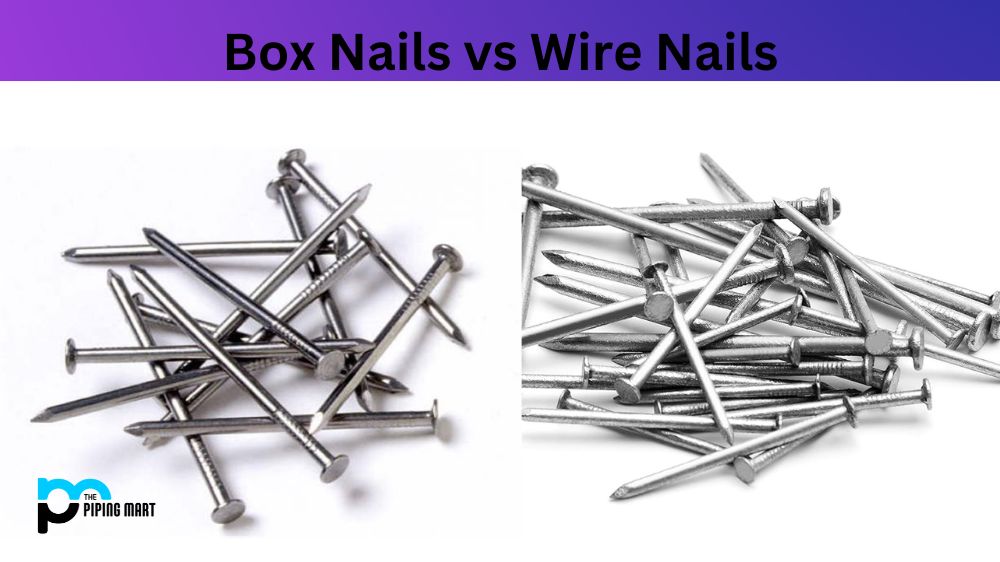When it comes to carpentry, choosing the right type of nail is critical to the project’s success. Box nails and wire nails are two of the most popular types of nails used in woodworking. While these nails may look similar, they have significant differences in durability, strength, and usage. As an expert in woodworking, I’d like to share the key differences between these two types of nails so that you can make an informed decision for your next woodworking project.
What is Box Nail?
Box nails are a type of nail specifically designed for use in woodworking. They have a wider head than standard nails, and the head is usually square or rectangular in shape. The shaft of the box nail is also slightly thicker than standard nails, making them more durable and better able to be driven into hardwoods without bending. Their unique design makes them ideal for creating strong boxes and frames.
What is Wire Nail?
A wire nail is a type of fastener consisting of a slender, metal shank with a flat head. It is typically used in carpentry and construction to affix two pieces of material together. The tapered shaft allows it to penetrate into wood surfaces more easily, while the broad head provides greater holding power than if using other types of nails. It is available in different lengths and sizes depending on the job at hand, making it very versatile for use in different applications.
Difference Between Box Nails and Wire Nails
Material
Box nails are usually made of low-grade steel with a thick shank and a smaller head. On the other hand, wire nails are made of high-grade stainless steel wire, which is heated and drawn into a nail. This makes wire nails superior in terms of strength and durability. Box nails are often considered a disposable option, whereas wire nails are more considered a permanent solution.
Head size
Box nails have a smaller head and are often used when appearance is insignificant, like in construction. Box nails are great for framing studs or making support beams or rafters since they don’t leave noticeable holes. Wire nails, however, have a larger round head that can be a great choice for projects where aesthetics are more important. They offer superior holding power; they’re perfect for finishing works such as base moulding or casing, where the nail head needs to sit flush with the wood.
Shank Size
Box nails typically have a thicker shank compared to wire nails. This makes them strong and sturdy, suitable for construction and rough carpentry that requires a stronger bond. The thicker shank also makes box nails more resistant to bending, making them ideal for outdoor projects such as building a shed or a deck. On the other hand, wire nails have a thinner shank, making them easier to work with, especially when reaching tight corners. They’re perfect for detailed carpentry and finer work like trimming.
Corrosion-resistance
Wire nails are usually made of high-grade stainless steel, making them less prone to rust and corrosion. This property makes them more corrosion-resistant than box nails, typically made from lower-grade steel. If you’re working on an outdoor project or planning to use the nails in damp environments, wire nails are the better choice since they offer superior resistance to the elements.
Length and Gauge
Length and gauge are vital factors when choosing between box and wire nails. Box nails are typically shorter and come in various sizes with varying thicknesses. The thicker the nail, the stronger it is. On the other hand, wire nails are available in a wider range of lengths and gauges. This makes them ideal for carpentry projects, from light-duty to heavy-duty construction.
Conclusion:
In conclusion, understanding the differences between box and wire nails is essential for every woodworker, carpenter or tradesperson. Choosing the right nail for the job is vital to ensure the longevity and strength of the project. While box and wire nails may look similar, they have significant differences in material, head size, shank size, corrosion resistance, and length and gauge. By considering these differences, you can choose the perfect nail for your next woodworking project and have confidence in the durability and quality of your work.

A passionate metal industry expert and blogger. With over 5 years of experience in the field, Palak brings a wealth of knowledge and insight to her writing. Whether discussing the latest trends in the metal industry or sharing tips, she is dedicated to helping others succeed in the metal industry.




